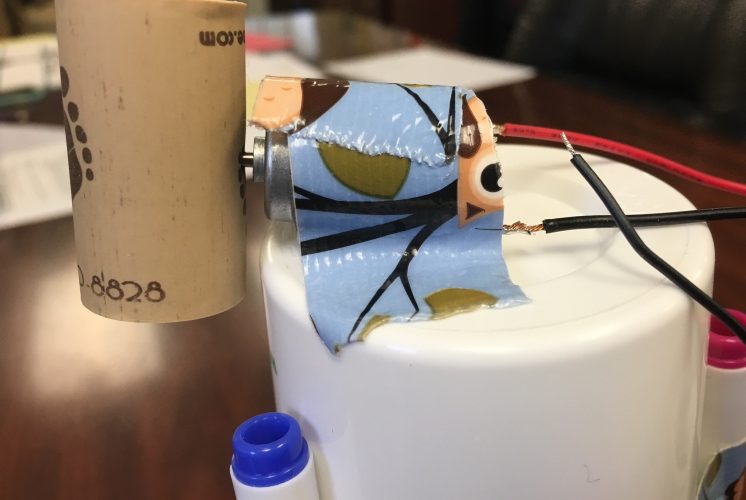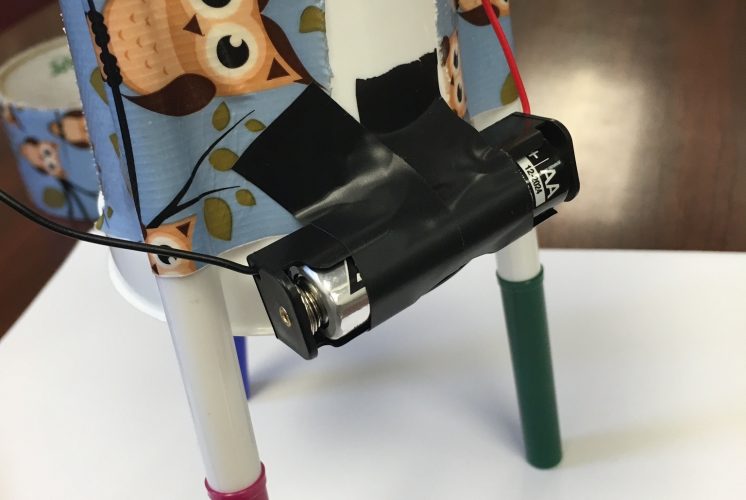Storytime: Nursery Rhymes
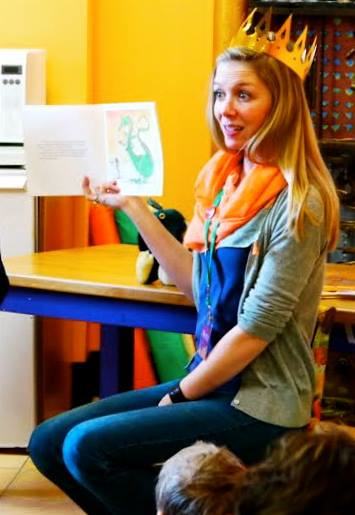 By Meredith Lamothe
By Meredith Lamothe
Hi there! I am the Lead Educator at The Children’s Museum of New Hampshire and also the host of Baby Storytime. I have a Bachelors Degree in Theatre from The University of Southern Maine and a Masters of Library and Information Science with a focus in Children’s Services from Simmons College.
I’m passionate about early literacy and excited to share information with you about our weekly Baby Storytime stories and activities. Join us for the next Baby Storytime which meets every Wednesday in the Museum's Primary Place exhibit at 9:45am.
NURSERY RHYMES
We started with "Open Them, Shut Them," which we do every week. I thought I’d post the words here for anyone who doesn’t know this wonderful song/finger play.
Open them, shut them
Open them, shut them
Give a little clap clap clap!
Open them, shut them
Open them, shut them
Lay them in your lap
Creep them, creep them
Creep them, creep them
Right up to your chin chin chin!
Open up your little mouth…But do not let them in!
I love that one!
The reason we do this rhyme every week and why I will commonly use the same rhymes/songs/finger plays is because repetition is so important for babies and for early literacy! Even though we, as adults, may get tired of hearing the same rhyme/song over and over again–babies enjoy hearing the same things over and over again. They gain familiarity with the actions and words and are able to play along. They’re also learning vocabulary from those songs and rhymes and each time we sing the song or say the rhyme it is a little different and babies will always be getting something different out of our repetitions!
LITERACY TIP
Our literacy tip today is about rhythm in rhymes or songs. Babies are learning to speak our language just as we would have to learn to speak a new language–to many of them our words sound like big long strings of sounds with no clear words or phrases. When we bounce babies on our laps while singing a song or saying a phrase or when we clap out words during a rhyme (this was tricky!) we’re helping to get them ready to read by knowing that a number of different words make up a sentence which makes up a story or song.
The rhyme that we clapped to was “To Market”
Here are the words:
To market, to market to buy a fat pig
Home again, home again, jiggety-jig
To market, to market to buy a fat hog,
Home again, home again, jiggety-jog
This is another fun rhyme about Rain!
Rain on the green grass,
And rain on the tree;
Rain on the house top,
But not on me!
The Wacky Scientist Reflects on his Career
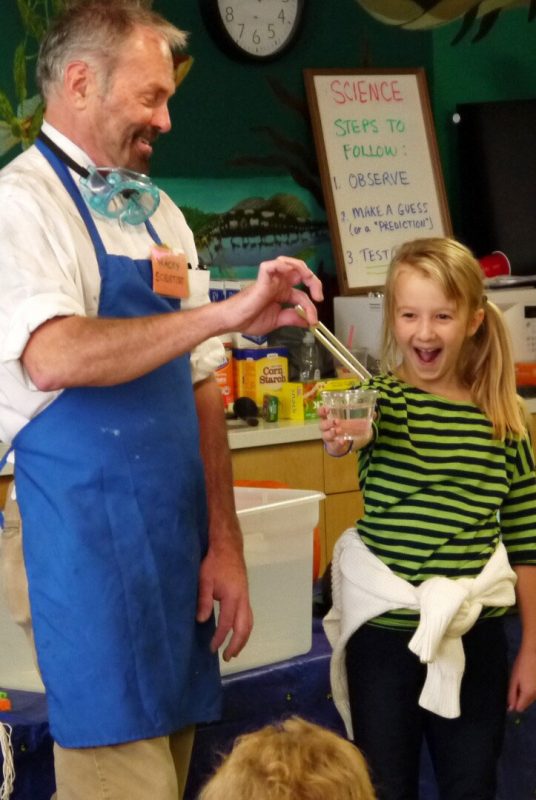
By Doug Tilton
I have had the honor of being the “Wacky Scientist” for the Children’s Museum of New Hampshire for about 14 years now and I spend all year preparing for and looking forward to the October Not-So-Spooky Spectacular! I’m actually the second “Wacky Scientist” to hold this position. The first Wacky Scientist was a former employee named Bill Stroup. He and Jane, our current President, came up with the slightly misleading moniker of “Wacky Scientist.” I’ve never thought of myself as particularly “wacky” (but I suppose I have my moments). In my pre-wacky days I actually did a lot of theatre and directing, which I think has served me well when trying to keep my young audience attentive and entertained.
I had presented science concepts to children’s audiences for years and directed others to do it, but still, the first time I did it as the Wacky Scientist was still a new experience. I relied on my fellow educators to help develop the science experiments that have become a signature highlight of our Halloween celebrations. Then as time went on, I started creating my own experiments and made sure that each show was different and unique!
A few of my favorite experiments over the years have included anti-gravity in a jar, “sink or float,” giant gyroscope, Coke and Mentos explosion and screaming balloons! Of course there are always unexpected surprises. Sometimes those surprises come in the form of costumed kids who want to talk to their friends through my experiments, or perhaps think they already know all about what I’m doing. THEY are the ones I make into my first assistants! Hey, every Wacky Scientist needs a Wacky Assistant. It’s in the bi-laws.
Of course, being a Wacky Scientist, or a Wacky Assistant, isn’t all fun and games. Occasionally it requires some serious dedication and risk taking. One year I was working the kinks out of a fantastic experiment where I used a bungee cord to drop a raw egg from the ceiling onto my assistant’s face! We carefully measured everything to make sure that the bungee would stop the egg from hitting his face at the very last second. Let’s just say, the Wacky Assistant’s dedication was tested that day, as were my Wacky nerves. But in the end, we measured correctly and didn’t end up with any egg on our face, literally or idiomatically.
Are you bringing your wacky kids to this year’s Not-So-Spooky Spectacular?
Storytime: The Royal Duke of York
By Meredith Lamothe
Hi there! I am the Lead Educator at The Children’s Museum of New Hampshire and also the host of Baby Storytime. I have a Bachelors Degree in Theatre from The University of Southern Maine and a Masters of Library and Information Science with a focus in Children’s Services from Simmons College.
I’m passionate about early literacy and excited to share information with you about our weekly Baby Storytime stories and activities. Join us for the next Baby Storytime which meets every Wednesday in the Museum's Primary Place exhibit at 9:45am.
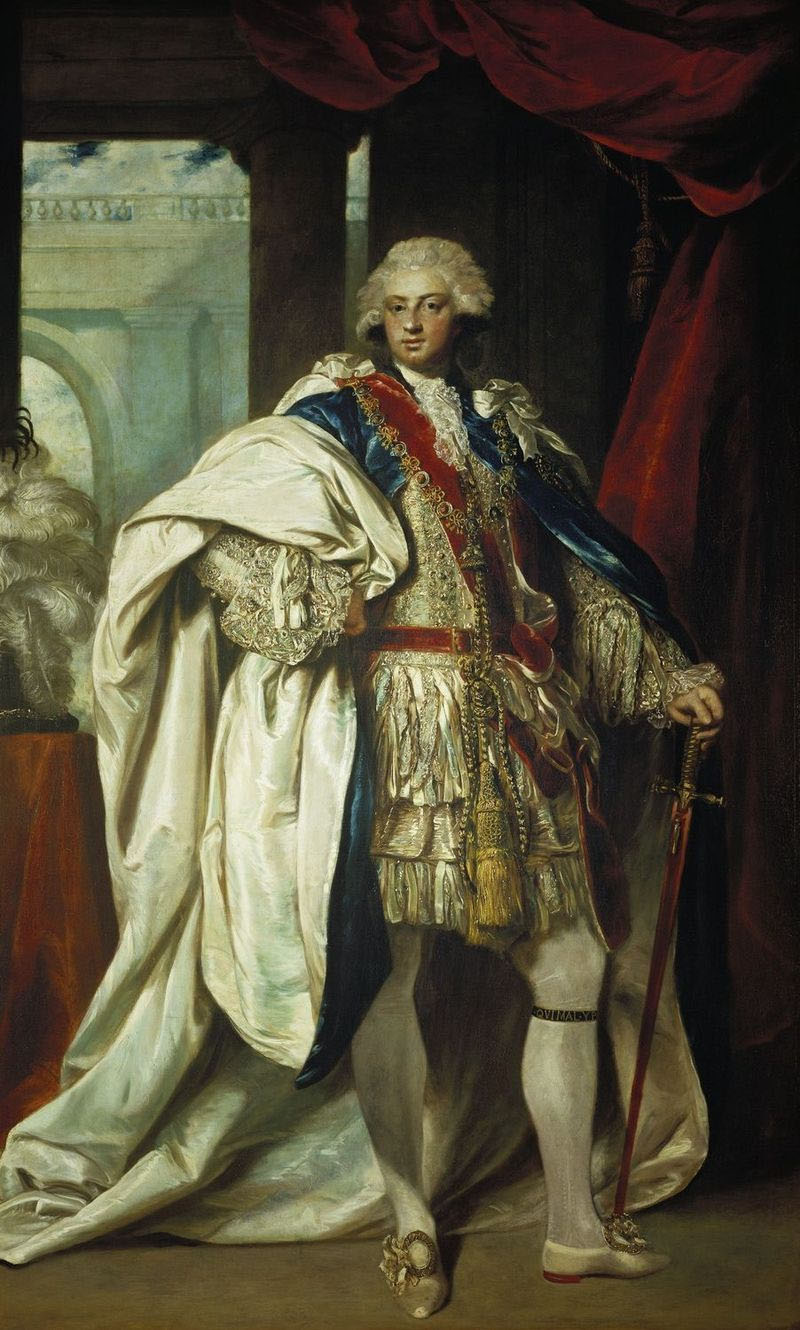 NURSERY RHYMES
NURSERY RHYMES
I had a request for the lyrics to “The Royal Duke of York” (otherwise known as "The Grand Old Duke of York") as well as the motions – so here they are!
BOUNCE: The Royal Duke of York (This is sung to the tune of “A Hunting We Will Go”)
Bounce babies on lap. When you say “up,” lift them up, when you say “down,” sit them back down in your lap.
Oh, the Royal Duke of York,
He had ten thousand men,
He marched them up the mountain top
and marched them down again.
Oh, when you’re up, you’re up.
And when you’re down, you’re down.
And when you’re only halfway up,
You’re neither up nor down.
He rolled them to the left.
He rolled them to the right.
He rolled them backwards down the hill
Oh what a silly sight!
LITERACY TIP
Singing and saying Nursery Rhymes is a great way to get babies ready to read! Children who know nursery rhymes by heart tend to have an easier time learning to read because playing with the rhymes (whether saying them or singing them) helps them to understand how words come together and go apart!
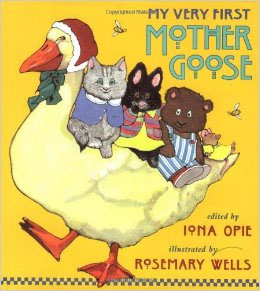 The Mother Goose Story book we used today is one of my favorites and is illustrated by Rosemary Wells, here’s a link to the Amazon listing: http://www.amazon.com/My-Very-First-Mother-Goose/dp/1564026205
The Mother Goose Story book we used today is one of my favorites and is illustrated by Rosemary Wells, here’s a link to the Amazon listing: http://www.amazon.com/My-Very-First-Mother-Goose/dp/1564026205
Meet the CMNH Staff: Doug Tilton
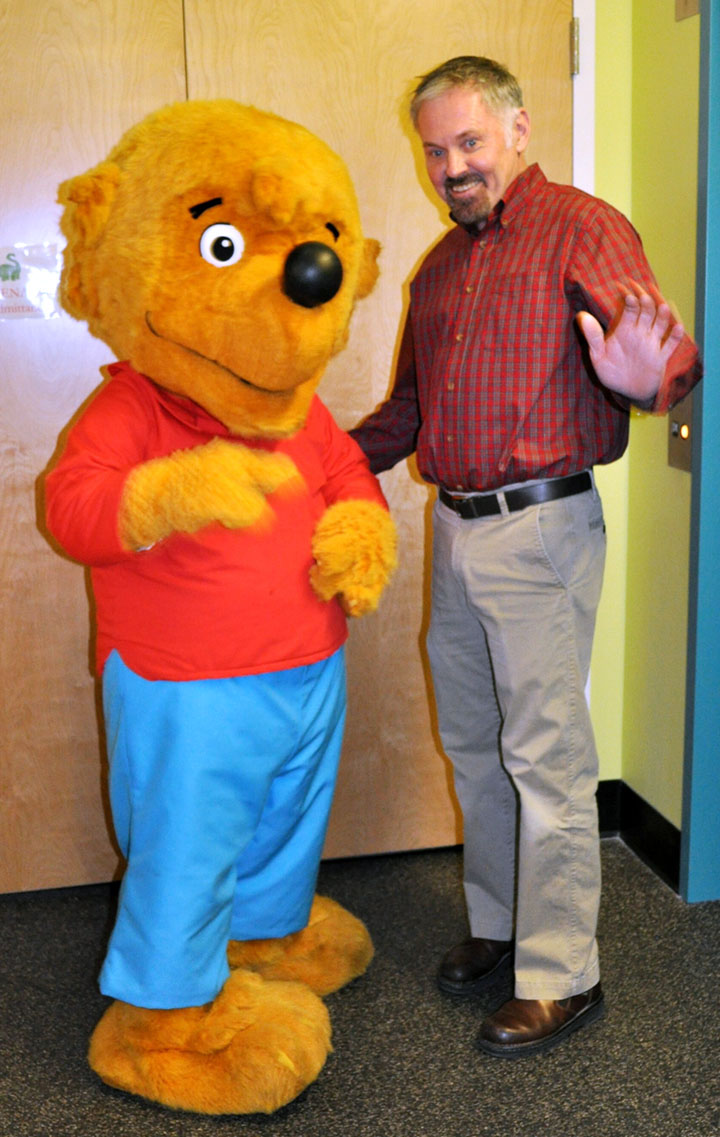 Name: Doug Tilton
Name: Doug Tilton
Title: Visitor Services and Operations Director, Volunteer and Intern Coordinator
How Long He Has Worked at CMNH: 16 years
What is the most fun part of your job?
I like it when I get to see programs and events work well. I also like to see Museum visitors engaged and getting a lot out of the experience.
What is something people might not know about you?
I’m a puppeteer and I trained other people to be puppeteers for years. I never took a theater course, but I ran a theater for 14 years. I was the Associate Director of the Little Red Wagon Touring Program and I helped with New Hampshire outreach.
What is your favorite exhibit at CMNH and why?
The Post Office. I like it because it has mailboxes throughout the museum so it encourages kids to explore other exhibits. Also, there are so many things to do there, sorting mail, delivering mail, running the post office. It even helps kids learn to read!
Science Art
Junior Science: Ages 3.5-5
By Meredith Lamothe
Hello Science Families!
We’re halfway done with this session of science–I say it every time, but it always surprises me when we get to this point!
Today was all about opposites in junior science class!
We specifically focused on BLACK and WHITE! It was fun to talk about alllllll the many colors that we’ve learned about and all the shapes and then to step back and look at something as simple as black and white.
We talked about how black and white are opposites and some other things that are opposite (UP and DOWN, Smooth and Bumpy, Left and Right, Open and Close!)
ACTIVITY #1: Floating Crayons
Then it was onto our first experiment! We explored crayons! We wanted to see if a bunch of crayons on our trays would SINK or FLOAT (opposites!) We dropped in crayons–which made a great splash sound!–and then observed what they did. We noticed something very odd. All of our crayons were sinking EXCEPT our black crayons! Those floated!
We learned that black crayons float because the pigment used to make the black color isn’t as heavy as the pigments used to make the other color crayons.
Then we tried to see if there was anything on our table that might help the other crayons float. We couldn’t find any floaties or pool noodles–but we did see some salt. What would happen if we added salt to our water? WE tried it! After we added a whoooooole bunch of salt, all of our crayons started to float! We learned that this was because we were changing the density of the water and making it a lot easier for the crayons to float–just like it’s easier for us to float in the salt water of the ocean!
ACTIVITY #2: Black and White Process Art
Our next activity was experimenting with black and white paints. We started by using a little brush and trying out some black paint. Then we used a BIG brush and added some white paint. Those become gray! We kept experimenting, added some collage pieces, and just paint, paint painted!
 (This photo is from Pinterest, but our paintings used the same idea!)
(This photo is from Pinterest, but our paintings used the same idea!)
Our paintings were still veeeery damp at the end of class, so we’ll have to take them home next week–they’re looking more and more interesting as they dry!
See you next week!
Best,
Meredith
Early Learning Exhibits and Programs Take Center Stage
Children’s Museum of NH sponsors bring new life to popular programs and spaces
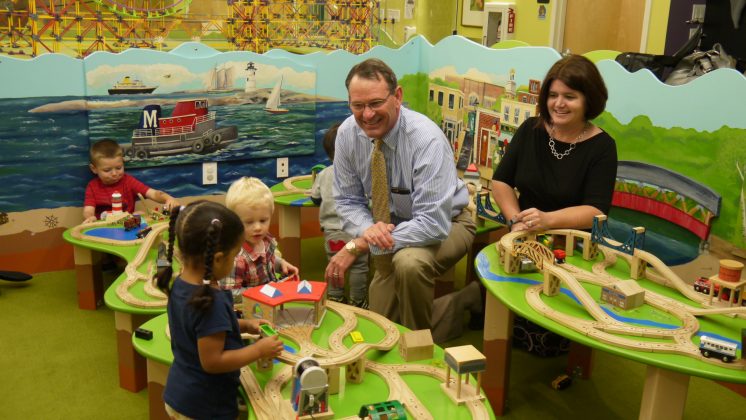
CEO of Wentworth-Douglass Hospital Greg Walker and Children’s Museum of New Hampshire President Jane Bard, along with some young guests, enjoy the newly spruced Primary Place of which Wentworth-Douglass Hospital is the sustaining sponsor.
Favorite fall programming for the younger set has begun at the Children’s Museum of NH. Wee Ones Wednesdays, which has a huge following with CMNH families, is now proudly sponsored by the Bank of New Hampshire. This drop-in class for walkers and talkers ages 2-4 is described by museum educators as “PRE-preschool.”
“This class is so popular that we offer two sessions, one right after the other in order to accommodate more kids,” says Education Coordinator Xanthi Gray. Beth Pagliuca, who has been bringing her children to Wee Ones since her daughter was a week old, said
“I loved Wee Ones as a first school style experience for my children. They learned to sing songs with their peers, do a craft and sit quietly eating a snack while listening to a story. All while still having the comfort of a parent or caretaker right there in the room with them. I think it helped prepare both my children for preschool because they both started preschool with big smiles and no concerns.”
After families take part in this or other Early Learning Programs such as Shake, Rattle and Read baby storytime or Junior Science Explorers, they can make their way to the second floor of the museum where the Primary Place, an Early Learning Landscape has gotten a major refresh from the exhibit’s Sustaining Sponsor, Wentworth-Douglass Hospital. This exhibit is designed specifically for the museum’s youngest visitors and the wear and tear on the beloved baby butterfly garden, animal puppets, giant box and train table are evidence of the over 700,000 kids that have enjoyed this space since 2008. “We are thrilled to support the exhibit,” says Dawn Fernald, Director of Marketing and Public Relations at Wentworth-Douglass Hospital.
“The Children’s Museum is a treasure in our community and provides wonderful experiences for families centering on education, history and culture with fun and interactive displays. The wow factor is huge!”
The Children’s Museum’s recent Toddlerfest celebration, which highlights all these programs, exhibits and more designed specifically for their youngest guests, culminated on Sunday, October 4 with Train Day from noon to 2pm. The trains, which are also featured in the second floor Primary Place, are a favorite exhibit and this program allows families to not only play in the museum, but also take a trolley to the Dover Rail Yard where they can climb on and explore a real locomotive.
Makers Gonna Make
by Sarah Terry
First things first...
Hi there!
As this is my first blog post for the museum, I thought I'd start with a quick introduction! My name is Sarah, and I'm an educator at CMNH. I've been working here for about three years, and I've done everything from putting on a production of “The Little Red Echidna” (an adaptation of “The Little Red Hen,” of course!) to talking everyone's ears off (children, parents, and staff alike) about NASA's New Horizons mission on Pluto Day! I'm a poet, sci-fi nerd, enthusiastic baker, and can bust out soprano arias in four different languages if asked (I have never been asked...).
I'm also a maker.
But... what exactly is a maker? The museum hosts the Dover Mini Maker Faire, there are makerspaces popping up all around - it's a maker revolution! But what does it mean? Even when I first started hearing that word thrown around, it was obvious that it was about more than just people making stuff (although people making stuff is super cool all by itself!). The Maker movement has taken on its own philosophy – it's about learning, creativity, DIY, technology, curiosity... Want to know how a computer works? Take it apart and look! Want to create a beautiful piece of jewelry? Grab some wire and beads and experiment! But I think perhaps the most important part of the maker movement is this: All these cool things you want to try...you don't have to do them in a vacuum.
The maker movement emphasizes learning through doing, but it also encourages social interaction.
It encourages getting together and figuring something out with your friends, and finding a makerspace where you can learn from experts, or passionate amateurs, or somebody who tried the same thing last week! It's about sharing knowledge, and sparking curiosity – nurturing our innate and insatiable desire for the how and why behind everything.
It's with that philosophy in mind that I started working on CMNH's newest traveling program – our MAKER CLUB! Beginning this fall, we're bringing 4-week sets of after-school activities to schools in the area that focus on all different kinds of creations and the science behind making them. I've been having such an awesome time creating the curriculum that I wanted to share some of the projects we're going to be working on!
Session One of Maker Club is all about electricity!
We'll be playing with circuits and lights and fans and motors, and learning about how electricity moves through them all. We'll also be creating these nifty guys:
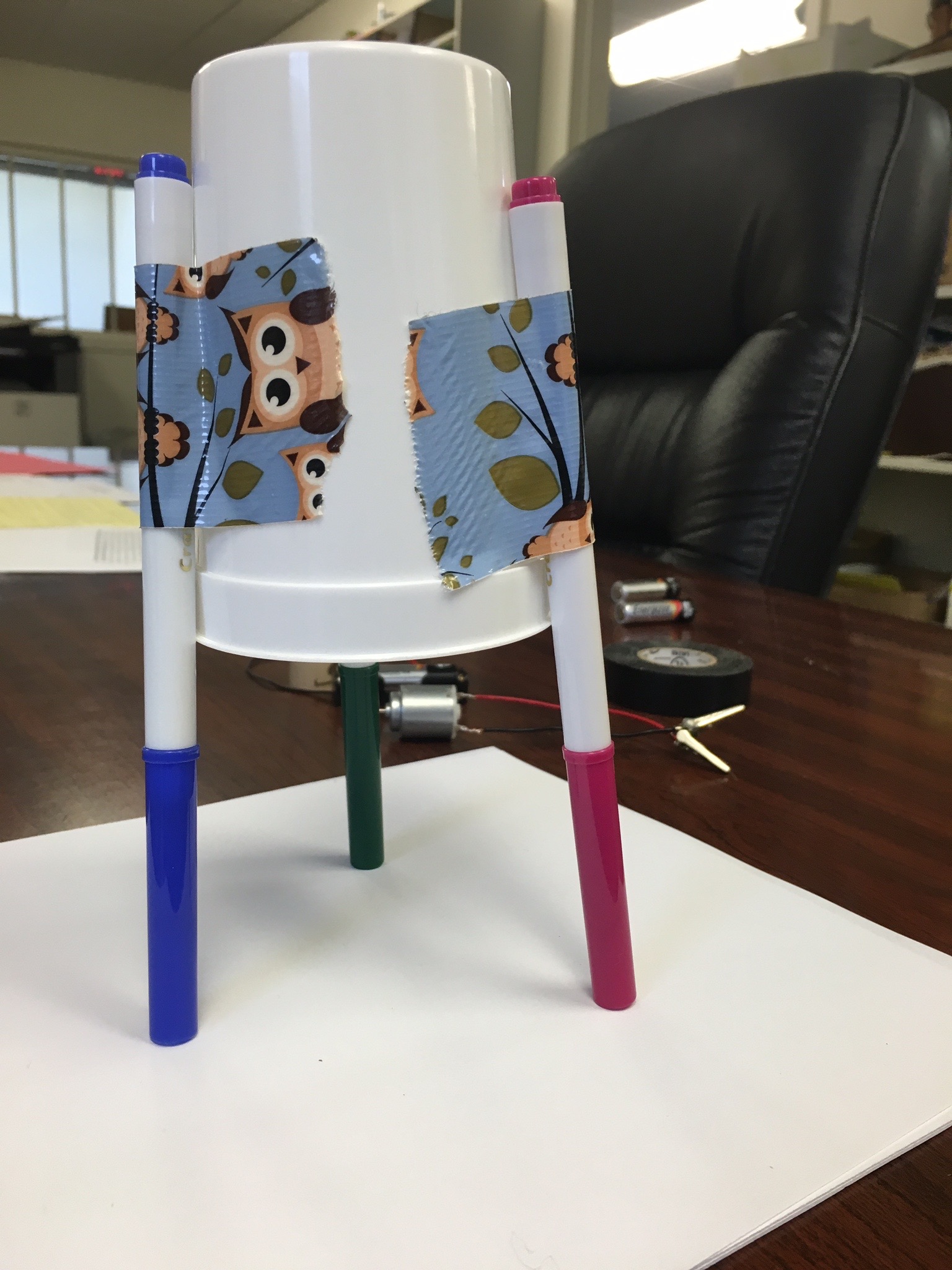
This is an ArtBot! It only takes a few simple parts to make one – there are even kits available online that have everything included. But if you want the option to customize all your parts and experiment with different techniques, you might want to buy the pieces separately.
Here's everything I used to make the ArtBot pictured here:
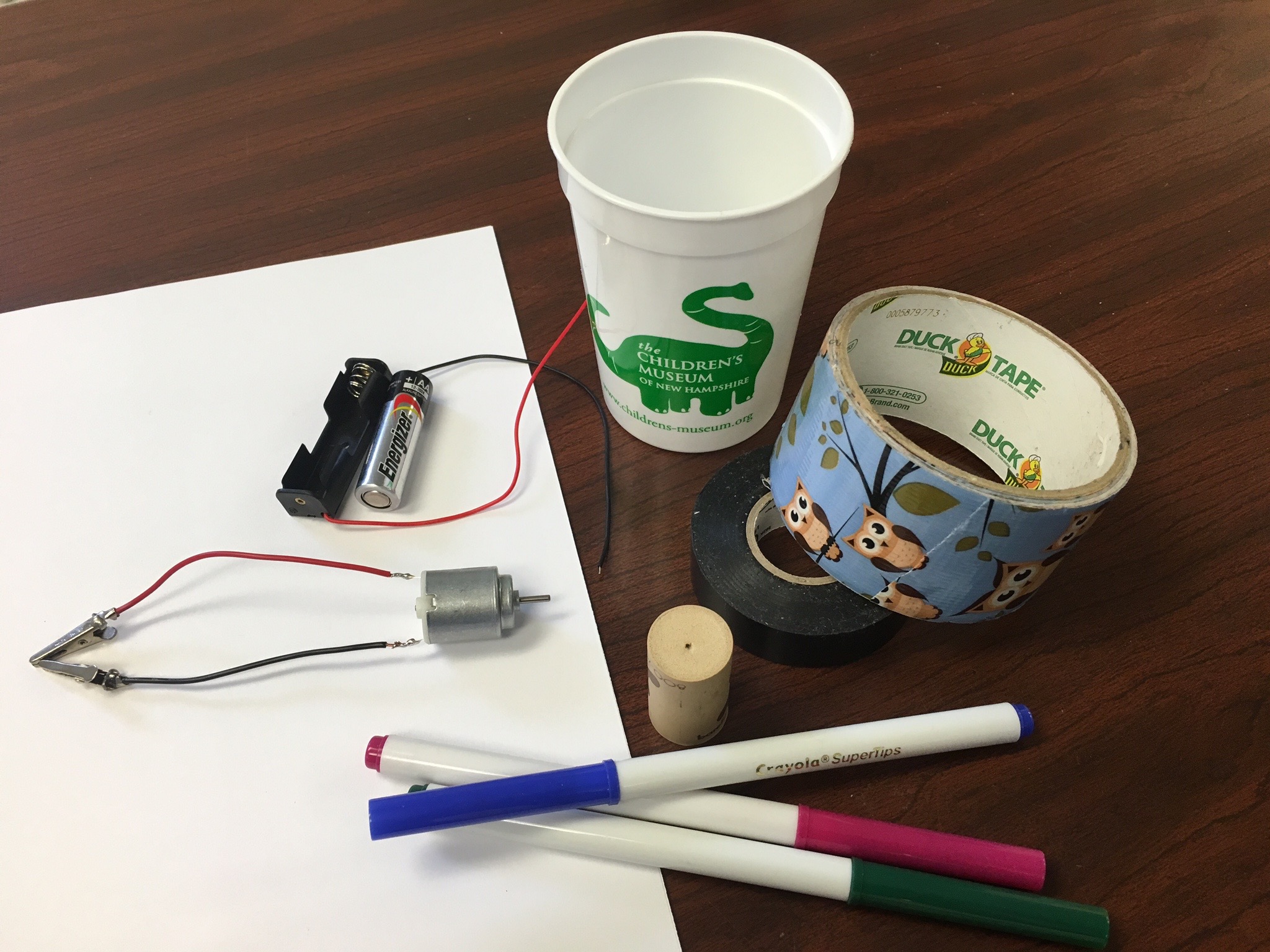
Materials:
- Plastic cup
- Duct tape
- Electrical tape
- Three markers
- Cork
- AA battery
- AA battery holder (optional)
- 1.5 – 3V mini motor
- Thin insulated wire with alligator clips
- Lots of paper!
Now, I went through an extra step before I got started and soldered lead wires onto the motor itself, but you can also just get wires with clips and clip them right onto the motor. But I really wanted to learn how to solder! It's neat!
Get the complete step-by-step instructions here in a handy dandy printable PDF.
Wow! Look at that ArtBot go!
Now how can you change the movement of your ArtBot? The ArtBot moves because the spinning cork puts it slightly off-balance and starts to shake it around. You can see in some of the video that I added aluminum foil to the cork to change the balance. How else can you change the balance? Could you add more markers? Move the battery or the motor? Check it out for yourself!
Bonus pictures of soldering!
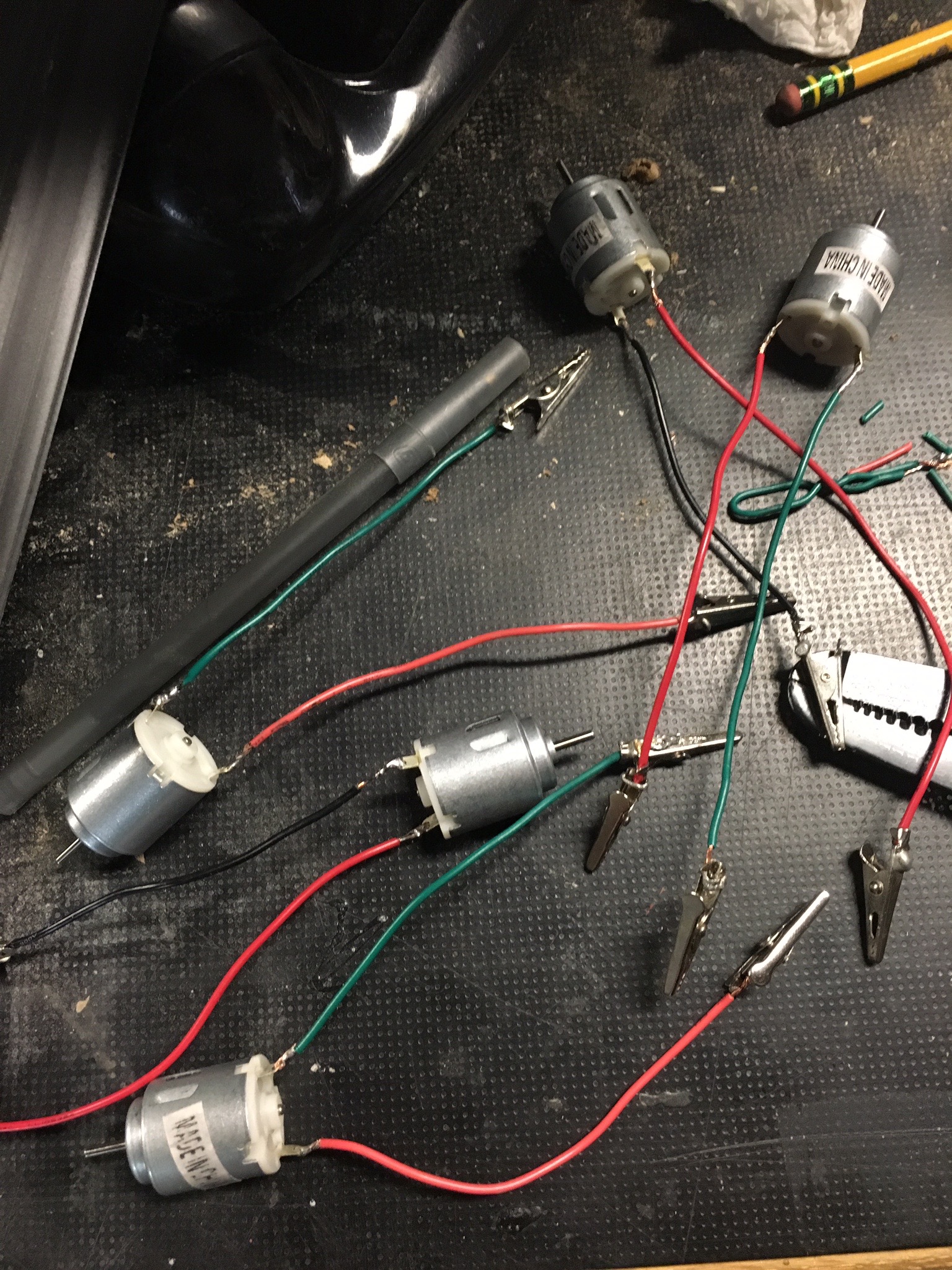
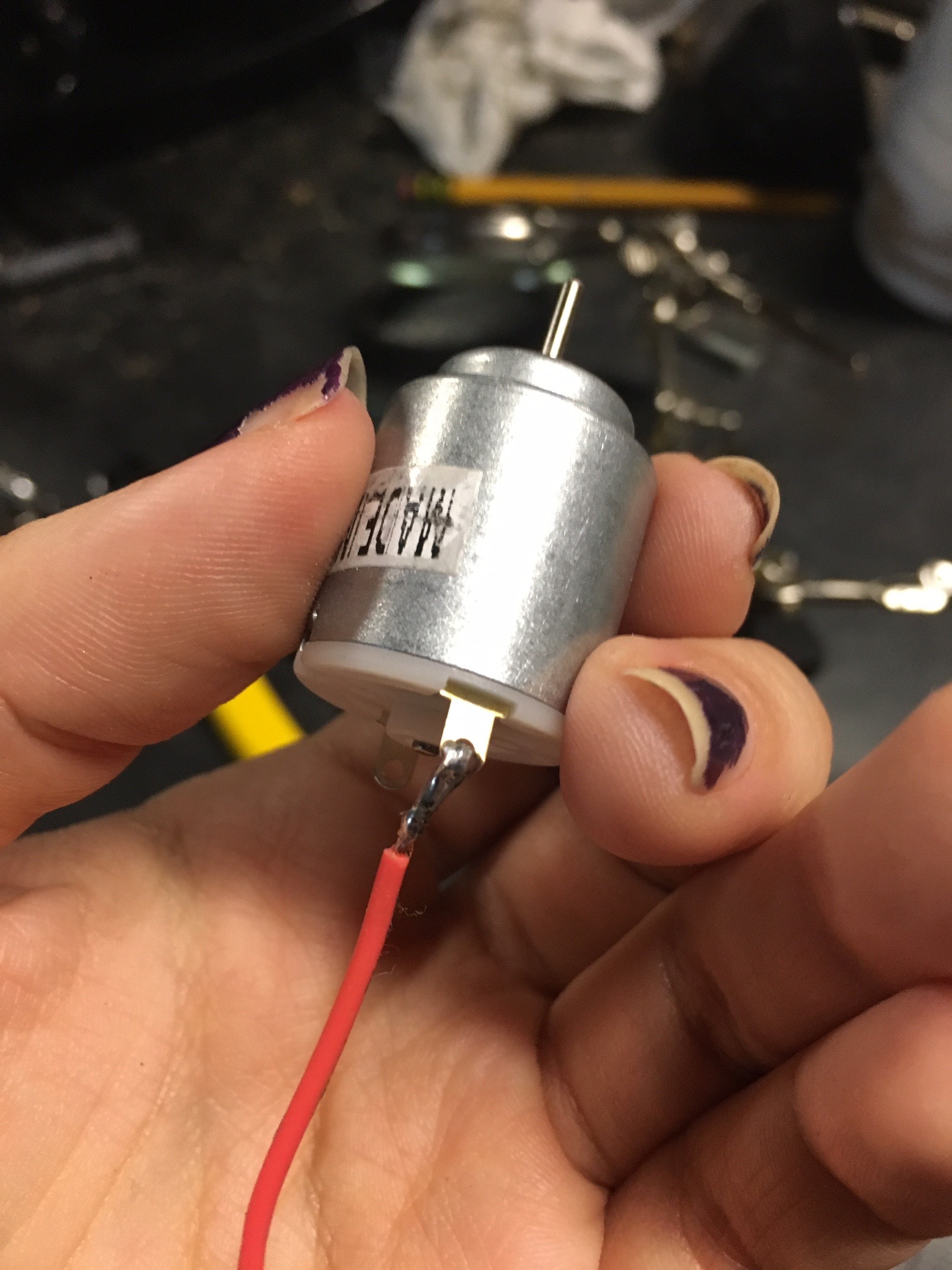 Soldering is the process of joining together two or more metal items by melting and flowing a filler metal (called solder) between them! It involves high temperatures and molten metal, but it is actually pretty easy to do (at least to do poorly – my joints work but aren't exactly pretty!). Consider buying a soldering iron, and trying it out for yourself. There are a ton of instructions online, or you could check out a local maker group like Port City Makerspace in Portsmouth, NH, and see what resources they have available!
Soldering is the process of joining together two or more metal items by melting and flowing a filler metal (called solder) between them! It involves high temperatures and molten metal, but it is actually pretty easy to do (at least to do poorly – my joints work but aren't exactly pretty!). Consider buying a soldering iron, and trying it out for yourself. There are a ton of instructions online, or you could check out a local maker group like Port City Makerspace in Portsmouth, NH, and see what resources they have available!
Want to learn a little more about electricity? Check out this information sheet from our Maker Club!
Meet the CMNH Staff: Paula Rais
 Name: Paula Rais
Name: Paula Rais
Title: Vice President of Development and Community Engagement
How Long She Has Been at CMNH: Almost 14 years (since September 2002)
What is the most fun part of your job?
The most fun part of my job is watching the families enjoy the museum and getting to know them. I love to hear stories of how the Museum has impacted people’s lives.
What is something that people might not know about you?
I make my own cards for my family but I am a really bad artist so they are hysterical. I mostly just draw stick figures and my family gets a kick out of them!
What is your favorite exhibit at CMNH and why?
My favorite exhibit is Cocheco Industry because I really like the historical part of it.




